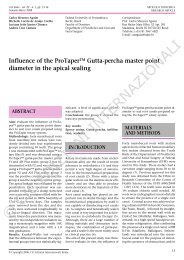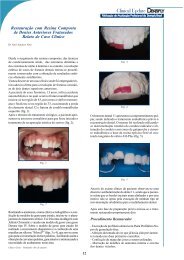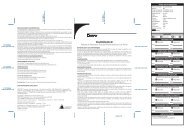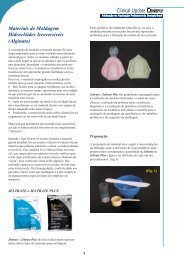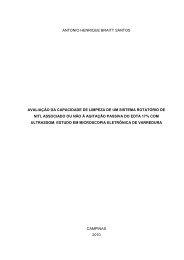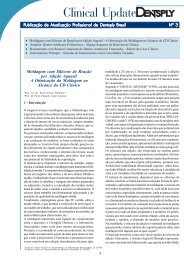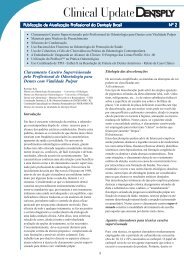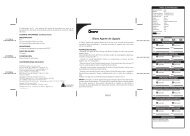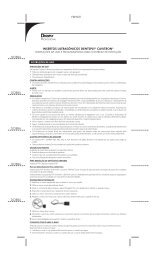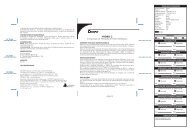You also want an ePaper? Increase the reach of your titles
YUMPU automatically turns print PDFs into web optimized ePapers that Google loves.
Microleakage of Class V Composite Restorations Placed<br />
with Etch-and-Rinse and Self-etching Adhesives Before<br />
and After Thermocycling<br />
Juan Ignacio Rosales-Leal a<br />
Purpose: To evaluate the sealing ability of etch-and-rinse and self-etching adhesives in Class V cavities before and<br />
after thermocycling in vitro.<br />
Materials and Methods: Etch-and-rinse adhesives (Prime & Bond NT [P&B], XP Bond [XPB], ScotchBond 1 XT [SBX],<br />
Syntac [SYN]) and self-etching adhesives (Xeno III [XNO], i-Bond [IBO], Clearfil SE Bond [CLF]) were used. A microleakage<br />
test was performed to evaluate marginal sealing. Seventy molars were divided into seven groups according to the<br />
adhesive used. Class V cavities were restored and each group was divided into two subgroups. One group was water<br />
immersed for 24 h and the other was thermocycled. Then, specimens were immersed in fuchsin and sectioned. Microleakage<br />
and dentin permeability were recorded on occlusal and gingival walls and data were statistically analyzed.<br />
Results: Etch-and-rinse adhesives provided perfect occlusal sealing. Self-etching adhesives obtained slight occlusal<br />
leakage. In the gingival wall, XNO and CLF showed the lowest leakage, followed by XPB and SBX, then P&B. SYN and<br />
IBO exhibited the highest leakage. All SE adhesives and XPB provided sealed dentinal tubules. Thermocycling did not<br />
affect the occlusal sealing but reduced the gingival sealing when P&B, SYN, XNO, CLF, and IBO were used.<br />
Conclusion: In enamel, marginal leakage was prevented when phosphoric acid was used. Self-etching adhesives promoted<br />
slight occlusal leakage. The gingival sealing was poorer than the occlusal sealing. XNO, CLF followed by XPB<br />
obtained the best gingival sealing. Thermocycling did not affect the occlusal bonding but reduced the gingival sealing,<br />
except when XPB and SBX were used.<br />
Keywords: adhesives, Class V sealing, thermocycling, in vitro.<br />
J Adhes Dent 2007; 9: 255-259. Submitted for publication: 15.12.06; accepted for publication: 3.1.07.<br />
Sealing of a cavity is one of the most important requirements<br />
for the durability of a composite restoration. 13 Microleakage<br />
of a restoration may be the starting point of secondary<br />
caries and the treatment failure. 11 The bond needs<br />
to be hermetic but also durable over time. 3,21<br />
In vitro microleakage tests offer very useful data about<br />
the sealing behavior of adhesives. A microleakage test provides<br />
information about the sealing of the interface and the<br />
dentin tubule sealing (dentin permeability). 1,16 Results are<br />
close to clinical reality because extracted human teeth and<br />
clinical protocols are used. 7,11<br />
Two different classes of adhesives are currently used.<br />
Etch-and-rinse adhesives require a separate acid-etching<br />
step prior to the adhesive infiltration that promotes an aggressive<br />
substrate treatment. 15 Self-etching adhesives etch<br />
and infiltrate at the same time, but their acidity is less than<br />
that of phosphoric acid, resulting in less etching depth. 19<br />
More information is necessary about the sealing ability of<br />
current adhesives (etch-and-rinse vs self-etching) and the effect<br />
of aging on the durability of the sealing. The purpose of<br />
this work was to evaluate the in vitro sealing ability of etchand-rinse<br />
and self-etching adhesives in Class V cavities before<br />
and after thermocycling.<br />
a Assistant Professor, Department of Stomatology (Dental Materials), University<br />
of Granada, Granada, Spain.<br />
Paper presented at Satellite Symposium on Dental Adhesives, Dublin,<br />
September 13th, 2006.<br />
Reprint requests: Dr. Juan Ignacio Rosales-Leal, Camino de Ronda, 57-2ºB,<br />
18004 Granada, Spain. Tel: + 34-653-32-03-84, Fax: +34-958-240-908.<br />
e-mail: irosales@ugr.es<br />
MATERIALS AND METHODS<br />
The adhesives used are described in Table 1. Seventy third<br />
molars were divided into 7 groups as a function of the adhesive<br />
used (Table 1). In each specimen, two Class V Cavities<br />
(3 x 2 x 2 mm [depth] with a 1-mm 45-degree enamel<br />
Vol 9, Supplement 2, 2007 255



